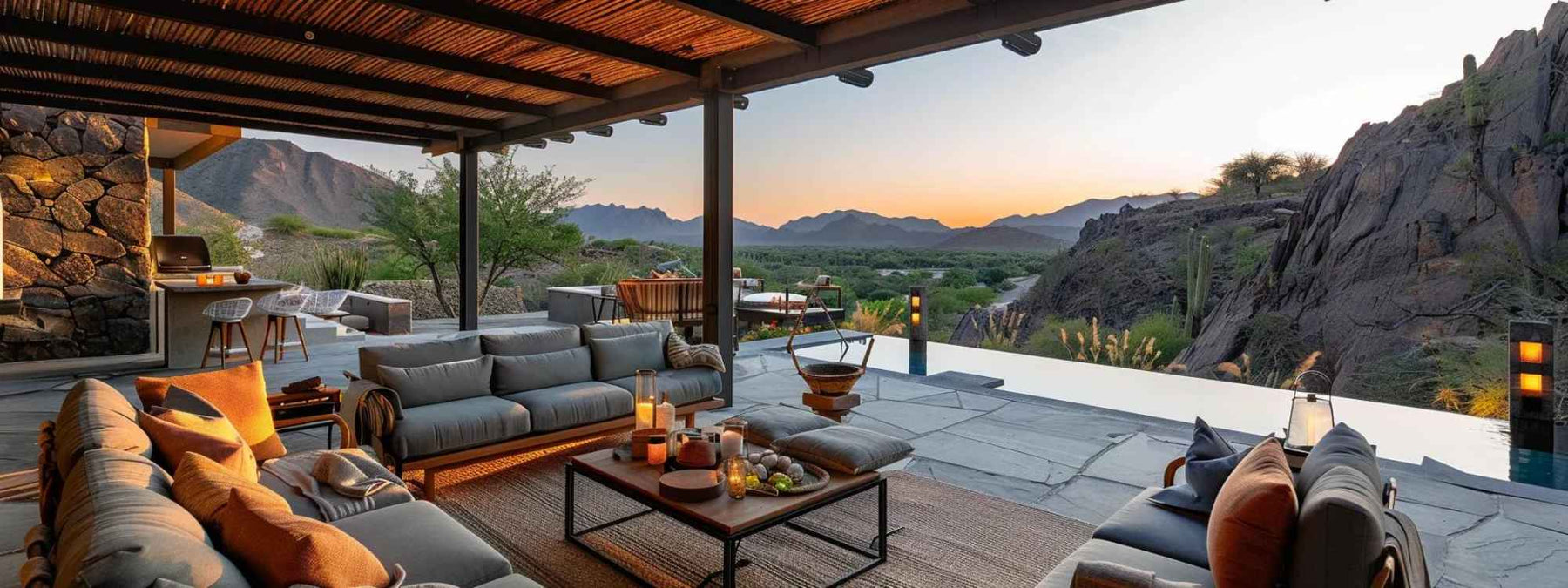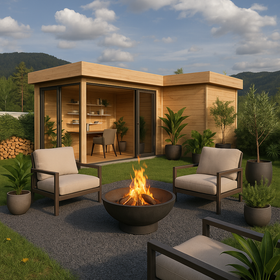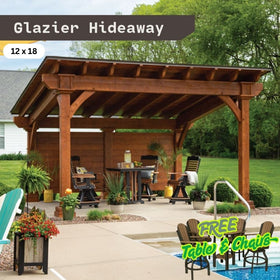512-777-0154

5 Mistakes People Make When Designing Their Retreat Spaces at Home
When people picture an at-home retreat, it usually looks like something out of a magazine. Cozy lounge chairs. A glowing fire pit or fireplace. Maybe some soft string lights overhead.
But making that image a reality? That’s where things start to unravel.
It’s easy to get swept up in trends. A few clicks, some impulse buys, and suddenly you’ve got a mismatched setup that doesn’t feel relaxing—or even usable.
Designing an outdoor living retreat space isn’t about chasing perfection. It’s about avoiding a few common mistakes that quietly ruin the vibe before it even begins.
Mistake #1: Prioritizing style over how you live
You’ve seen the photos.
The perfect backyard with crisp white cushions. A sleek lounger angled just right. Maybe a Warming Trends AON Steel Circular Fire Pit Table that looks like it’s never seen actual flames.
It’s easy to fall for that look. Social media makes it tempting. You scroll, get inspired, and start planning your setup based on the prettiest things you see.
But here’s the catch: your life isn’t a photo shoot.
Designing an outdoor retreat space around style instead of lifestyle is where most people trip up. The result? An outdoor living space that looks great but never gets used.
Start by asking yourself a simple question: How do you want to spend time out here?
Reading a book in peace? Hosting a few friends for dinner? Stretching out for an afternoon nap?
Once you’re clear on how you want to use the space, it gets a lot easier to choose the right pieces. Comfortable outdoor seating. Durable fabrics. Layouts that make sense for your day-to-day life.
Style matters, but not more than function. A retreat isn’t about impressing anyone. It’s about creating something that works for you.
So, before you chase the perfect aesthetic, check if it fits the way you live.
Mistake #2: Forgetting that shade is non-negotiable
Shade isn’t flashy. It doesn’t photograph well. But if you skip it, your retreat space won’t get used for long.
An uncovered patio might look great in the morning. But by early afternoon? You’re dealing with a heat trap. Bright light, harsh glare, and zero comfort. Not exactly the place you imagined spending a slow afternoon.
That’s the thing about outdoor spaces, they’re at the mercy of the sun. And the sun moves. A spot that’s perfect at 10 am might be unbearable by 2.
So, before you fall in love with the look of an open deck or sunny corner, think about how that space feels during the hottest parts of the day.
You don’t need to build a full roof. There are simple fixes.
A well-placed Brookside Timber Frame Timber Resort Pergola. Planting a tree might take time, but it’s a long-term win.
Shade also pulls double duty. It helps your outdoor furniture last longer and keeps your cushions from fading or cracking. Less maintenance. More comfort.
The goal isn’t to block all light—it’s to give yourself the option to escape it when you need to.
Mistake #3: Trying to cram too much into one space
This is where things often go sideways.
You start with good intentions—maybe a cozy chair and a Warming Trends AON Steel Square Fire Pit Table. Then you add a dining table. A hammock. A couple of planters. A yoga mat. And suddenly, someone gifts you a garden gnome you feel weird about getting rid of.

Now everything’s packed into one tight 12x12 space.
And instead of feeling calm, it feels like a storage room with a view.
It’s easy to think more features = better space. But that usually leads to clutter. And clutter makes it harder to relax, move, or even breathe properly when you’re out there.
Here’s a better way to think about it: empty space is part of the design. Not everything needs to be filled.
Pick two main ways you want to use the outdoor space. Maybe it’s lounging and dining. Or reading and gardening. Whatever it is, patio design around those two, and let the rest go.
If you want to include more, try dividing the space into zones. Soft rugs can define a lounge area. Planters or lighting can create a quiet corner. Even small shifts help give the space more purpose—and more room to breathe.
When every corner has a job, nothing feels relaxing.
So instead of squeezing in everything you love, focus on what you’ll use. The rest can wait.
Mistake #4: Not thinking about lighting until it’s too late
Most people design for the daytime.
They picture morning coffee in the sun. Or maybe lunch with a light breeze. But when the sun sets? The space fades out of use.
That’s a missed opportunity.
Evening is when outdoor spaces can shine. Quiet dinners. Slow conversations around a fire pit. Reading under the stars. All of it depends on one thing—light.
Without it, the space disappears. Or worse, becomes a tripping hazard.
The good news? You don’t need to install anything complicated. A few simple additions can go a long way.
Use soft lighting where you’ll sit or gather—like string lights, lanterns, or small table lamps. Add subtle ground lighting to guide walkways or stairs. Solar or battery-powered options keep things easy. No wires. No digging.
It’s not about making it bright. It’s about making it usable. And comfortable.
Lighting also changes the mood. A few warm bulbs can shift the whole feel of a space, without a big price tag.
Mistake #5: Leaving out the stuff that makes it feel like yours
They look great. But they don’t feel like anyone lives there.
That’s usually because the garden design came straight from a catalog or someone else’s Pinterest board. And while those images are nice, they’re not you.
A retreat should feel personal. That’s what makes it inviting.

It could be the LuxCraft Arcadia Furniture Set you always read in. A weird little side table you found at a flea market. Or maybe a small fountain that helps drown out traffic noise. These small touches matter.
They give the space a bit of soul.
You can also add layers through the senses. A soft blanket on a cool chair. Lavender planted in the LuxCraft Square Planter near the steps. Wind chimes from a trip you still think about. Even the sound of bamboo rustling nearby can shift the mood.
None of this needs to be expensive. Or perfect.
It just needs to mean something to you.
Because the best retreat spaces don’t just look good. They feel like a place you want to be.
So, before you add more decor, ask yourself a simple question: Does this make the space feel like mine?
Design Isn’t the Goal. Comfort Is.
Designing a relaxing outdoor space isn’t about chasing trends. It’s not about turning your backyard into a glossy magazine spread, either.
It’s simpler than that.
Avoiding a few common mistakes can transform how your yard feels. And you don’t need an outdoor living design degree or a hefty budget to make it happen. You just need a bit of thoughtfulness.
Maybe it’s adding some shade where it matters. Or clearing out the clutter that crept in over time. Pick one thing, fix it, and notice how the space starts to feel different.
Small changes add up fast. Each adjustment gets you closer to a retreat you want to use.
If you’re looking for more tips or some easy inspiration, check out our other blog posts. They’re practical, straightforward, and designed to help you get the most out of your outdoor spaces.
Because in the end, the goal isn’t perfection. It’s about building a backyard you can truly enjoy, no pressure, no fuss, just a space that feels right.






